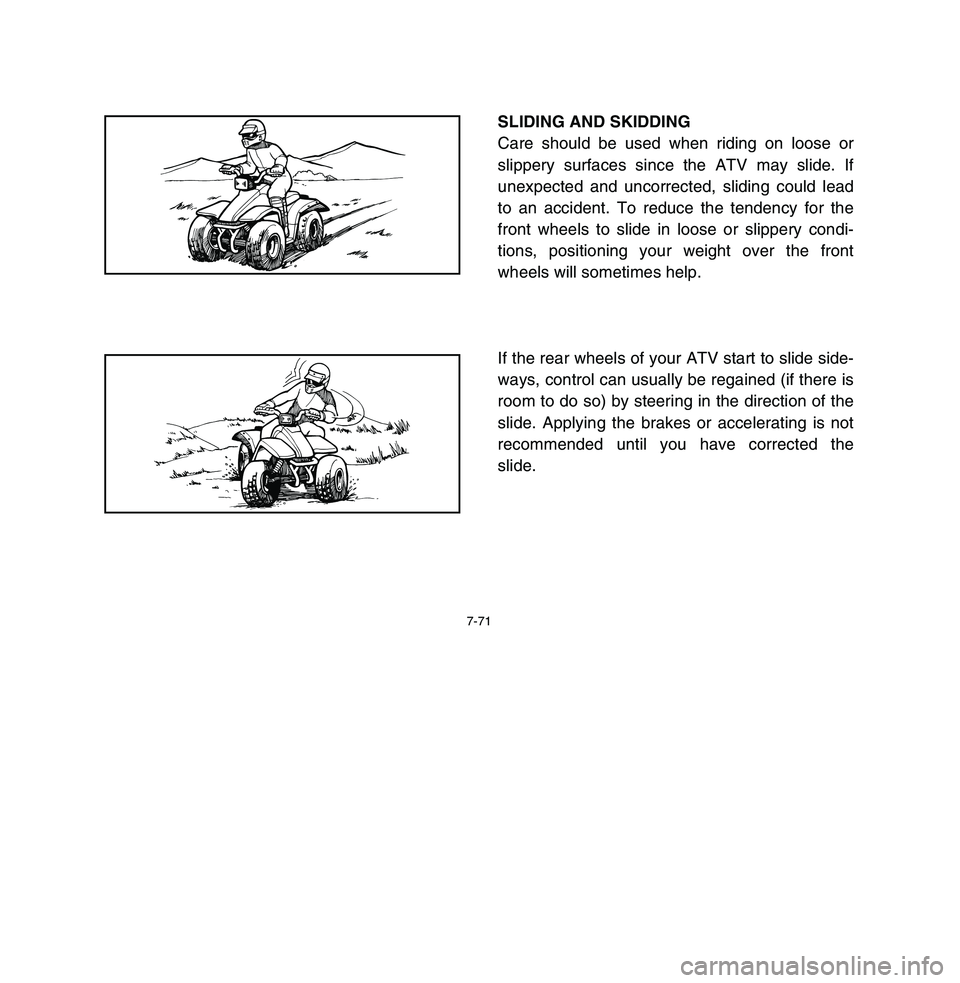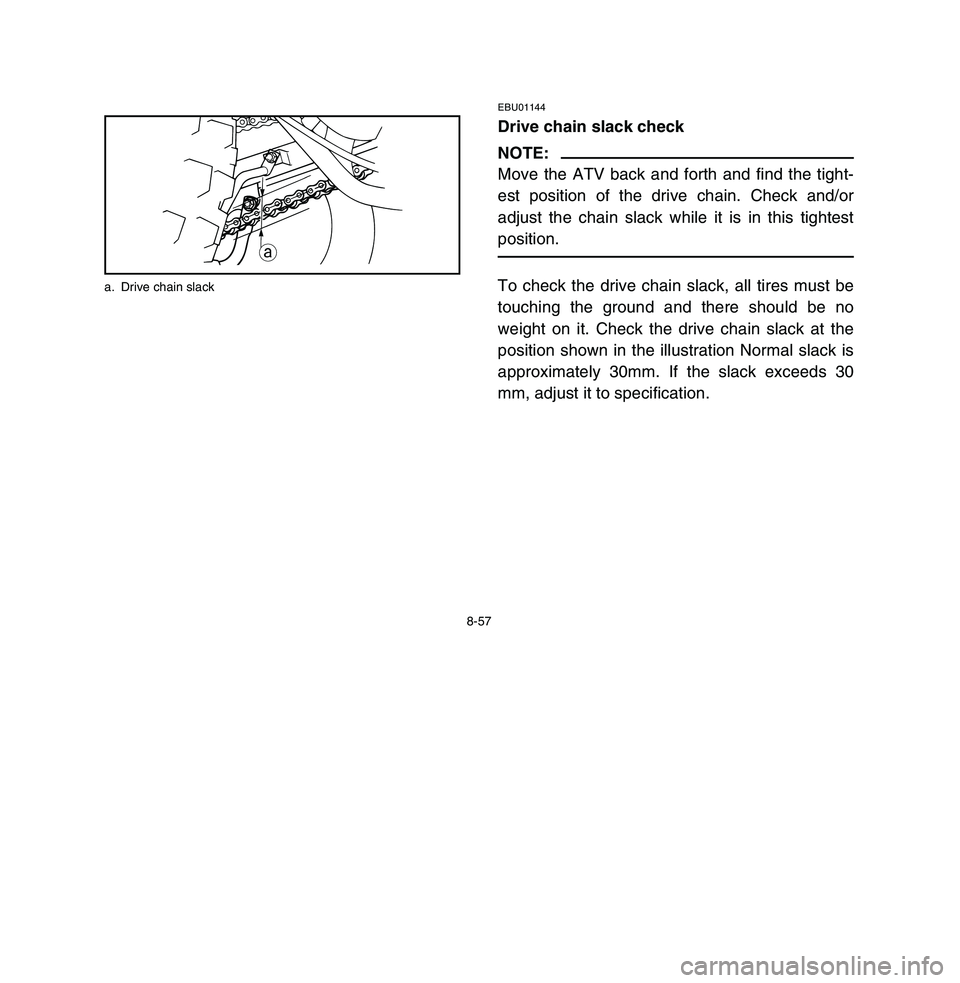weight YAMAHA BREEZE 2003 User Guide
[x] Cancel search | Manufacturer: YAMAHA, Model Year: 2003, Model line: BREEZE, Model: YAMAHA BREEZE 2003Pages: 350, PDF Size: 5.24 MB
Page 197 of 350

7-55
wMaintain steady speed when climbing a hill.
If you lose all forward speed:
8Keep weight uphill.
8Apply the brakes.
8Lock parking brake, after you are stopped.
If you begin rolling backwards:
8Keep weight uphill.
8Never apply the rear brake while rolling
backwards.
Apply the front brake.
When fully stopped, apply rear brake as
well, and then lock parking brake.
Dismount on uphill side or to a side if point-
ed straight uphill. Turn the ATV around and
remount, following the procedure described
in the Owner's Manual.
5VJ-9-60-07 3/26/02 9:15 PM Page 56
Page 199 of 350

7-57
RIDING DOWNHILL
When riding your ATV downhill, shift your weight
as far to the rear and uphill side of the ATV as
possible. Move back on the seat and sit with
your arms straight. Improper braking may cause
a loss of traction.
Use caution while descending a hill with loose or
slippery surfaces. Braking ability and traction
may be adversely affected by these surfaces.
Improper braking may also cause a loss of trac-
tion.
Whenever possible, ride your ATV straight
downhill. Avoid sharp angles which could allow
the ATV to tip or roll over. Carefully choose your
path and ride no faster than you will be able to
react to obstacles which may appear.
5VJ-9-60-07 3/26/02 9:15 PM Page 58
Page 201 of 350

7-59
wAlways follow proper procedures for going
down hills as described in this Owner's
Manual. Note: a special technique is required
when braking as you go down a hill.
8Always check the terrain carefully before
you start down any hill.
8Shift your weight backward.
8Never go down a hill at high speed.
8Avoid going down a hill at an angle that
would cause the vehicle to lean sharply to
one side.
Go straight down the hill where possible.
OK
5VJ-9-60-07 3/26/02 9:15 PM Page 60
Page 203 of 350

7-61
CROSSING A SLOPE
Traversing a sloping surface on your ATV
requires you to properly position your weight to
maintain proper balance. Be sure that you have
learned the basic riding skills on flat ground
before attempting to cross a sloping surface.
Avoid slopes with slippery surfaces or rough ter-
rain that may upset your balance.
As you travel across a slope, lean your body in
the uphill direction. It may be necessary to cor-
rect the steering when riding on loose surfaces
by pointing the front wheels slightly uphill. When
riding on slopes be sure not to make sharp turns
either up or down hill.
5VJ-9-60-07 3/26/02 9:15 PM Page 62
Page 205 of 350

7-63
If your ATV does begin to tip over, gradually
steer in the downhill direction if there are no
obstacles in your path. As you regain proper bal-
ance, gradually steer again in the direction you
wish to travel.wNever attempt to turn the ATV around on any
hill until you have mastered the turning tech-
nique as described in the Owner's Manual on
level ground. Be very careful when turning
on any hill. Avoid crossing the side of a
steep hill if possible.
When crossing the side of a hill:
8Always follow proper procedures as
described in the Owner's Manual.
8Avoid hills with excessively slippery or
loose surfaces.
8Shift your weight to the uphill side of the
ATV.
OK
5VJ-9-60-07 3/26/02 9:15 PM Page 64
Page 213 of 350

7-71
SLIDING AND SKIDDING
Care should be used when riding on loose or
slippery surfaces since the ATV may slide. If
unexpected and uncorrected, sliding could lead
to an accident. To reduce the tendency for the
front wheels to slide in loose or slippery condi-
tions, positioning your weight over the front
wheels will sometimes help.
If the rear wheels of your ATV start to slide side-
ways, control can usually be regained (if there is
room to do so) by steering in the direction of the
slide. Applying the brakes or accelerating is not
recommended until you have corrected the
slide.
5VJ-9-60-07 3/26/02 9:16 PM Page 72
Page 217 of 350

7-75
WHAT TO DO IF ...
This section is designed to be a reference guide
only. Be sure to read each section on riding
techniques completely.
WHAT TO DO ...
8If your ATV doesn't turn when you want it to:
Bring the ATV to a stop and practice the turn-
ing maneuvers again. Be sure you are putting
your weight on the footboard to the outside of
the turn. Position your weight over the front
wheels for better control. (See pages 7-41 –
7-45.)
8If your ATV begins to tip while turning:
Lean more into the turn to regain balance. If
necessary, gradually let off the throttle and/or
steer to the outside of the turn. (See pages
7-41 – 7-45.)
5VJ-9-60-07 3/26/02 9:16 PM Page 76
Page 221 of 350

7-79
8If your ATV is traversing a sloping surface:
Be sure to ride with your weight positioned
towards the uphill side of the ATV to maintain
proper balance. If the ATV starts to tip, steer
down the hill (if there are no obstacles in your
way) to regain balance. If you discover that
the ATV is going to tip over, dismount on the
uphill side. (See pages 7-61 – 7-63.)
8If your ATV encounters shallow water:
Ride slowly and carefully through slow mov-
ing water, watching for obstacles. Be sure to
let water drain from the ATV and CHECK
YOUR BRAKES FOR PROPER OPERATION
when you come out of the water. Do not con-
tinue to ride your ATV until you have regained
adequate braking ability. (See pages 7-65 –
7-67.)
5VJ-9-60-07 3/26/02 9:16 PM Page 80
Page 279 of 350

8-57
EBU01144Drive chain slack checkNOTE:
Move the ATV back and forth and find the tight-
est position of the drive chain. Check and/or
adjust the chain slack while it is in this tightest
position.To check the drive chain slack, all tires must be
touching the ground and there should be no
weight on it. Check the drive chain slack at the
position shown in the illustration Normal slack is
approximately 30mm. If the slack exceeds 30
mm, adjust it to specification.
a
a. Drive chain slack
5VJ-9-60-08 3/26/02 9:17 PM Page 8-58
Page 331 of 350

10-1
SPECIFICATIONS
Model YFA1
Dimensions:
Overall length 1,640 mm
Overall width 965 mm
Overall height 980 mm
Seat height 690 mm
Wheelbase 1,080 mm
Minimum ground clearance 145 mm
Minimum turning radius 2,900 mm
Basic weight:With oil and full fuel tank 144 kg
Engine:
Engine type Air-cooled, 4-stroke, SOHC
Cylinder arrangement Singlel cylinder, Forward-inclined
Displacement 124 cm
3
Bore × stroke 49 ×66 mm
Compression ratio 9.0 : 1
Starting system Electric starter
Lubrication system Wet sump
EBU00428
5VJ-9-60-09~11 3/26/02 9:18 PM Page 12